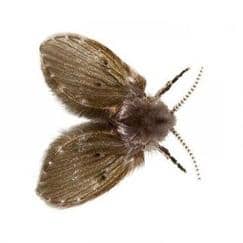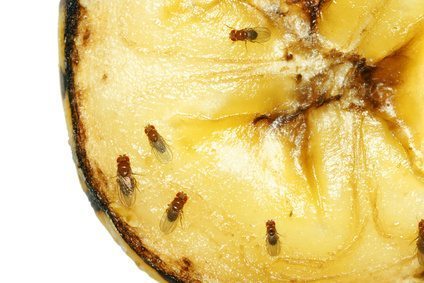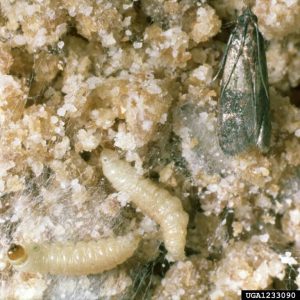Table of Contents
Drain Flies, Fruit Flies, and Indian Meal Moths
It doesn’t seem to matter how immaculate you keep your kitchen; you are bound to stumble into an infestation sooner or later.

What Are Pantry Pests?
Pantry bugs, also known as food pests or pantry pests, refer to a variety of small organisms that get into homes or commercial buildings or stores to invade and feed on the available food.
In homes, these pests are commonly found in food stores and cupboards where they surround the stored food, rendering it nearly or fully inconsumable by people. They mostly prefer feeding on grains, chocolate, dry cereals, spices as well as sugary foods and snacks.
Although these bugs are not harmful to your health and that of your family, they are a nuisance when they invade your food place in large numbers. Besides, who will want to share his or her food with these tiny creatures?
Why Are They in Your Kitchen?
No matter how clean your home is, your pantry is vulnerable to pantry bugs. The pantry pests in your home may have come from outdoors or were hiding inside the food products that you recently brought home.
In most cases, the pests are brought about by infested food products. In your business, the bugs are likely to come and establish themselves if you have food products that have been sitting in a particular area for a long time. That’s why they are common in processing warehouses and grocery stores.
Here are the three most common pantry pests you need to get rid of in your kitchen:
Drain Flies
Drain flies are a big nuisance. Buzzing around your personal space and annoying you until the point of madness; drain flies are probably a nasty New York pest that transmits harmful bacteria and diseases. We would like to relate some facts concerning drain flies and how to better remove these flies from your kitchen.

Drain Fly (Photo Credit: Creative Commons)
Drain Flies Facts
- Drain flies are also known as sewer flies.
- Drain flies are often confused with moths because of their wing size and furry bodies.
- They can contribute to asthmatic issues and can cause problems for those spending time in your home.
- Drain flies are more commonly found in the following places:
o Kitchen drains, especially those void of garbage disposal.
o Bathroom sinks, mostly because of neglect. More often people don’t bother with regular bathroom drain cleaning unless there is a clog.
o Shower/bathtub drains are also known for going long periods of time in between washings, so drain flies will often settle in there as well.
o Unused pipes that have been stagnant for an extended period.
o Indoor Houseplants. - Though drain flies can be relatively large as far as flies are concerned, they still can slip through small cracks, holes, and crevices in your home or business.
- Sewer lines under buildings also make for good nesting grounds.
- Drain flies will feed on almost anything from decomposed food to human waste.
- Drain flies carry serious diseases!
How to Naturally Get Rid of Drain Flies
1. Begin by cleaning the drain or drains.
2. Using a zip it drain cleaning tool, or something similar, remove the bulk build up from your drain.
2. Combine 1 part bleach to 5 parts water, and flush it down your drains, followed by approximately 4-5 cups of boiling water.
3. Continue treatment the following morning by pouring 1/2 cup of salt in the drain, immediately layer it with a 1/2 cup baking soda, and on the last layer pour 1 cup white vinegar. Allow the layers to set overnight.
4. Flush the drains with approximately 2-3 cups of boiling water.
5. To help prevent future drain fly outbreaks, be sure to maintain the pipes with the above directions periodically.
Fruit Flies
Fruit flies are one of the most common and annoying of pantry bugs. They seem to come from nowhere to take over a kitchen. One day you reach for a piece of fruit you’ve left out in a fruit basket, and there’s no problem. The next day, you’re swarmed by gnat-like fruit flies as you lift out the fruit. And once they’ve infested your home, fruit flies are some of the most difficult pantry bugs to get rid of.
Even though they are small in size, approximately 3 to 4 mm long, they are still very bothersome, to say the least. Some have red eyes while others have darker eyes with a tan thorax. The abdomen of a fruit fly is black and gray.
They might appear to be tan and sometimes brown, depending on the species. There are several species of fruit flies, olive fruit flies, Mexican fruit flies, Caribbean fruit flies, Western Cherry fruit flies, Mediterranean fruit flies and of course; citrus fruit flies.
Fruit flies can live and thrive in your home in fall and winter. Sure, they arrive when it’s warm out, through an open door or window or hole in a screen, but once inside your home they can take root quickly.
How is that possible? Consider the lifespan and reproductive capacity of a fruit fly. They mature into adulthood over the course of seven days and live for about a month under normal circumstances. An adult female fruit fly lays up to 500 eggs during her life, which means multiple generations of fruit flies branch out awful fast.

Fruit Flies
The Life of Fruit Flies
To understand how fruit flies can get into your home and how they can quickly spread, you first need to understand the biology of these pantry bugs. They feed off fermenting foods, and they lay their eggs near the surface of these foods, such as tomatoes, grapes, melons, bananas, and potatoes.
Virtually any ripe fruit or vegetable you can think of can attract fruit flies as it gradually becomes overripe and begins the process of rotting and fermentation. They can also be attracted to garbage cans, garbage disposals, empty bottles and cans, dirty mops and cleaning rags, and drains—anywhere where they can find a little fermenting material.
They only take about eight days to develop from egg to adult, and they lay about 500 eggs when they reproduce—so it’s easy to see how fruit flies can suddenly swarm your kitchen.
How Fruit Flies Get Inside
Fruit flies can smell ripe fruits and vegetables from a considerable distance, and attracted by that smell; they will enter your home through the tiniest of openings to get at the food you’ve left out.
If you have a garden, you may bring fruit fly larvae inside with fruits and vegetables you pick. This is one of the reasons why they are more prevalent in late summer and fall—that’s when there are the most fruits and vegetables reaching ripeness. You also can bring fruit fly larvae in on well-ripened produce you buy from the grocery store.

“Virtually any ripe fruit or vegetable you can think of can attract fruit flies as it gradually becomes overripe and begins the process of rotting and fermentation.”
-Rest Easy Pest Control
A recent study at the Lund University revealed that the ancestors of fruit flies were originally from southern Africa (what is now Zambia and Zimbabwe) and about 10,000 years ago they moved in from the wild to live amidst human populations. In the beginning, when fruit flies lived in the wild, the researchers said, they are picky eaters, only eat a specific type of fruit called marula.
The fruits attract fruit flies with distinctive smelling substances. Once they’re drawn to the substances, the receptors on their antennae are activated, signaling that it’s a favorable place to breed and lay eggs. However, having lived in human’s dwelling for a long time, fruit flies have adjusted their food source to variant overripe, rotten fruits, like citrus and whatever fruits in the fruit bowl.
How to Identify Fruit Flies Infestation in Your Kitchen
You can usually determine if this is the case if you notice them flying around your kitchen trash cans, where there might be decaying fruit and vegetables.
The fruit fly is also drawn to liquor; therefore, if you have liquor bottles in your trash, this will also attract fruit flies. Sometimes they are mistaken for roaches. This is only after they have bred and crawl out of their material. They are also mistaken for rodent droppings. The way to correctly identify them is by the pair of horns they have.
How to Keep Your Kitchen Free of Fruit Flies
Two preferred fruit fly spawning locales in your home are in your garbage and in your drain. The best way to keep your home free of fruit flies is to keep these two areas as clean as possible. Take out your garbage regularly and clean your drains often to keep them free of grease, food, and other substances fruit flies love.
To keep your home free of fruit flies, follow these common-sense guidelines:
- Seal off all openings into your home, such as holes in screens.
- Don’t leave overripe fruit sitting around—either eat it, put it in the refrigerator, or throw it away.
- Don’t leave fermentable food in indoor trash cans.
- Remove any food in your pantry (e.g., an old potato or onion) that’s begun to rot.
- Check for spills of juice, wine, or other fermentable liquid under the refrigerator or other out-of-sight areas.
How to Naturally Get Rid of Fruit Flies Infestation
- Fill a small, shallow bowl with equal parts vinegar and dish soap
- Set the bowl near the worst areas of infestation, such as your garbage area or kitchen sink
- Rinse and re-fill as needed when captured flies become too numerous
Indian Meal Moth

Indian meal moth by Clemson University – USDA Cooperative Extension Slide Series, Bugwood.org
If you’ve got a lawn or patio, and it’s got lights, then you’ve probably entertained some highly unwelcome guests: moths. Moths have a crazy affinity for light, and scientists don’t really understand why—although there are several theories.
One is that moths normally use the moon to guide their flights, and since there is normally no other illumination at night, moths mistake our patio lights for the moon and fly toward them. This seems like a pretty weak theory—as moths don’t normally fly directly toward the moon (or they would just fly into the stratosphere).
Moths use electromagnetic fields (which humans can’t see) as a sort of “compass.” Our patio lights disrupt these electromagnetic fields in such a way that the moths are attracted to the lights instead of wherever they would normally fly.
How Indian Meal Moths Get Inside
Indian meal moths are commonly found in stored grains since grains are one of their young ones’ most favorite foods. Besides grains and grain products, Indian meal moths also feed on cereals, food for pets, dry fruits, powdered milk, candies, chocolate, as well as other processed food products, especially the starchy ones.
An Indian meal moth is easily distinguishable from the rest of pantry pests due to its reddish-brown exteriors and whitish gray interiors.
“The tiny eggs of Indian Meal Moths can come into your house through food packages like bird seed, cereals and grains, flours, pet food, dried herbs, and powdered milk.
-Rest Easy Pest Control
How to Identify Indian Meal Moths or Pantry Moths
- Larvae in food: When you see that something moves when you’re pouring out your cereal or powdered milk, then it’s almost certain that you have pantry moths. A larva is a phase that causes damage to your food. When the eggs hatch, the larvae will spin silken threads in the contaminated food. You’ll also see tiny whitish worms and their discarded skins once they have moved away. Although they are tiny at the beginning of their life, they can grow to 3 inches long with black or brown heads. The larval phase generally lasts up to 3 months depending on circumstances.
- Larvae in the walls: You can examine your house by looking for larvae on the walls or ceiling. They like to hang in dark cracks and crevices to become a pupa and turn into moths.
- Cocoons: Moths in the pupal stage are in cocoons. They usually hide in cracks and crevices, on top of cabinets, or sometimes they are underneath the food. You can identify them when you see some matted webs and clumps in the food. Moths usually take up to 20 days to evolve from pupae stage into adults.
- Adult Flying Moths: Adult moths are brownish, have wings, and are attracted to light. They don’t have mouthparts and, thus, can’t eat. At this stage, their only aim is to reproduce. An adult female moth can lay around 400 eggs at a time, and they can hatch in a week.
Tips For Preventing Moth Infestation
- Clean your jars and cans. Throw packaged food products that are already expired.
- Turn on other lights. If your patio lights are the only light source around, the moths will inevitably flock there. So turn on the floodlights when you’re on your patio, or install yard lights away from the patio.
- Don’t use white lights. Moths have a stronger attraction to white lights than yellow ones.
- Citronella. For whatever reason, moths hate it. So burn some citronella candles on your patio, or spray some citronella directly on your light bulbs during the day—it will dry by nighttime, and the bulb will radiate the citronella outwards, repelling the moths.
Rest Easy Pest Control has the expertise, skills and superior equipment and chemicals to eradicate any pantry pests infestation. Our professionals will not only remove any pest intruding into your home but with regular, routine visits, we can help hinder any unwanted pest or critter from moving in into your home or business in the first place. Call us today to schedule your consultation!***
Last updated on December 28, 2018.
Related Articles:
